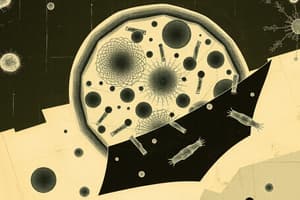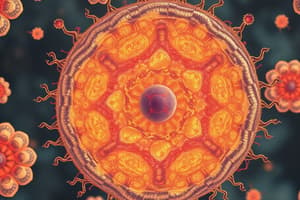Podcast
Questions and Answers
The double membrane structure in mitochondria, with its inner membrane folded into cristae, serves to increase ______ for ATP production.
The double membrane structure in mitochondria, with its inner membrane folded into cristae, serves to increase ______ for ATP production.
surface area
In plant cells, the ______, primarily composed of cellulose, provides essential support, protection, and gives the cell its shape, distinguishing it from animal cells.
In plant cells, the ______, primarily composed of cellulose, provides essential support, protection, and gives the cell its shape, distinguishing it from animal cells.
cell wall
The ______ is critical in eukaryotic cells as it houses the genetic material and is surrounded by a double membrane known as the nuclear envelope.
The ______ is critical in eukaryotic cells as it houses the genetic material and is surrounded by a double membrane known as the nuclear envelope.
nucleus
Unlike eukaryotic cells, ______ cells lack a membrane-bound nucleus, with their genetic material located in a region called the nucleoid.
Unlike eukaryotic cells, ______ cells lack a membrane-bound nucleus, with their genetic material located in a region called the nucleoid.
The ______ modifies, sorts, and packages proteins and lipids synthesized in the ER into vesicles for transport to other cellular destinations.
The ______ modifies, sorts, and packages proteins and lipids synthesized in the ER into vesicles for transport to other cellular destinations.
[Blank] like microfilaments, intermediate filaments, and microtubules, form a network that supports cell structure and facilitates movement.
[Blank] like microfilaments, intermediate filaments, and microtubules, form a network that supports cell structure and facilitates movement.
The ______, crucial for protein synthesis, can be found free in the cytoplasm or attached to the endoplasmic reticulum.
The ______, crucial for protein synthesis, can be found free in the cytoplasm or attached to the endoplasmic reticulum.
The primary function of ______ involves breaking down cellular waste and debris, digesting old organelles, and plays a crucial role in cellular recycling.
The primary function of ______ involves breaking down cellular waste and debris, digesting old organelles, and plays a crucial role in cellular recycling.
Found in plant cells and algae, ______ are responsible for photosynthesis, using chlorophyll to capture light energy to produce sugars.
Found in plant cells and algae, ______ are responsible for photosynthesis, using chlorophyll to capture light energy to produce sugars.
The ______, composed of a phospholipid bilayer, regulates the movement of substances into and out of the cell, maintaining cellular integrity.
The ______, composed of a phospholipid bilayer, regulates the movement of substances into and out of the cell, maintaining cellular integrity.
Flashcards
Cell Structure
Cell Structure
The organization of different components (organelles) within a cell to perform specific functions.
Prokaryotic Cells
Prokaryotic Cells
Cells lacking a membrane-bound nucleus and other complex organelles; generally smaller and simpler than eukaryotic cells.
Eukaryotic Cells
Eukaryotic Cells
Cells containing a membrane-bound nucleus and other complex organelles; generally larger and more complex than prokaryotic cells.
Nucleus
Nucleus
Signup and view all the flashcards
Endoplasmic Reticulum (ER)
Endoplasmic Reticulum (ER)
Signup and view all the flashcards
Golgi Apparatus
Golgi Apparatus
Signup and view all the flashcards
Lysosomes
Lysosomes
Signup and view all the flashcards
Mitochondria
Mitochondria
Signup and view all the flashcards
Cytoskeleton
Cytoskeleton
Signup and view all the flashcards
Cell Membrane
Cell Membrane
Signup and view all the flashcards
Study Notes
- Cell structure refers to the organization of different components within a cell
- These components are called organelles
- Organelles perform specific functions required for the cell to function correctly
- Cell structures can be studied using microscopy techniques
- Electron microscopy provides higher resolution compared to light microscopy
- All cells have some common structures, such as the plasma membrane, cytoplasm, and genetic material
- Cells are broadly classified into two types: prokaryotic and eukaryotic
Prokaryotic Cells
- Prokaryotic cells are generally smaller and simpler in structure compared to eukaryotic cells
- They lack a membrane-bound nucleus
- The genetic material (DNA) is located in a region called the nucleoid
- Prokaryotic cells do not have other membrane-bound organelles
- The cell wall provides support and protection
- The cell wall is composed of peptidoglycan in bacteria
- Some prokaryotes have a capsule outside the cell wall for protection and attachment
- Ribosomes are present for protein synthesis, but they are smaller than those in eukaryotes
- Some prokaryotes have flagella for movement
- Pili are small, hair-like structures involved in attachment and genetic material transfer
- Examples of prokaryotic cells include bacteria and archaea
Eukaryotic Cells
- Eukaryotic cells are larger and more complex than prokaryotic cells
- They possess a membrane-bound nucleus that houses the genetic material (DNA)
- Eukaryotic cells contain various membrane-bound organelles, each with specific functions
- Examples of eukaryotic cells include animal cells, plant cells, fungi, and protists
Nucleus
- The nucleus is the control center of the cell, containing the cell's DNA
- It is surrounded by a double membrane called the nuclear envelope
- Nuclear pores in the envelope regulate the movement of substances between the nucleus and cytoplasm
- The nucleolus is a structure within the nucleus where ribosomes are assembled
- Chromatin, composed of DNA and proteins, is found within the nucleus and condenses into chromosomes during cell division
Endoplasmic Reticulum (ER)
- The endoplasmic reticulum (ER) is an extensive network of membranes involved in protein and lipid synthesis
- There are two types of ER: rough ER (RER) and smooth ER (SER)
- RER has ribosomes attached to its surface and is involved in protein synthesis and modification
- SER lacks ribosomes and is involved in lipid synthesis, detoxification, and calcium storage
Golgi Apparatus
- The Golgi apparatus processes and packages proteins and lipids synthesized in the ER
- It consists of flattened membrane-bound sacs called cisternae
- Vesicles transport molecules between the ER and the Golgi, and between different Golgi compartments
- Proteins and lipids are modified, sorted, and packaged into vesicles for transport to other destinations
Lysosomes
- Lysosomes are organelles containing enzymes that break down cellular waste and debris
- They digest old or damaged organelles, as well as engulfed foreign materials
- Lysosomes play a crucial role in cellular recycling
Mitochondria
- Mitochondria are the powerhouses of the cell, responsible for generating ATP (adenosine triphosphate) through cellular respiration
- They have a double membrane structure, with an inner membrane folded into cristae to increase surface area
- Mitochondria contain their own DNA and ribosomes
Chloroplasts
- Chloroplasts are found in plant cells and algae and are responsible for photosynthesis
- They contain chlorophyll, a pigment that captures light energy
- Like mitochondria, chloroplasts have a double membrane and their own DNA and ribosomes
Cytoskeleton
- The cytoskeleton is a network of protein fibers that provides structural support and facilitates cell movement
- It consists of three main types of fibers: microfilaments, intermediate filaments, and microtubules
- Microfilaments are composed of actin and are involved in cell shape, movement, and muscle contraction
- Intermediate filaments provide structural support and stability
- Microtubules are composed of tubulin and are involved in cell division, intracellular transport, and the formation of cilia and flagella
Cell Membrane
- The cell membrane, also known as the plasma membrane, surrounds the cell and separates its contents from the external environment
- It is composed of a phospholipid bilayer with embedded proteins and cholesterol
- The cell membrane regulates the movement of substances into and out of the cell
- Proteins in the membrane can act as channels, carriers, receptors, or enzymes
Cell Wall
- The cell wall is a rigid outer layer found in plant cells, bacteria, fungi, and algae
- It provides support, protection, and shape to the cell
- In plant cells, the cell wall is primarily composed of cellulose
- Bacterial cell walls are composed of peptidoglycan
- The composition of the cell wall varies depending on the organism
Vacuoles
- Vacuoles are large, fluid-filled sacs found in plant and fungal cells
- They store water, nutrients, and waste products
- In plant cells, the central vacuole helps maintain cell turgor pressure
Ribosomes
- Ribosomes are responsible for protein synthesis
- They are found in both prokaryotic and eukaryotic cells
- Ribosomes consist of two subunits: a large subunit and a small subunit
- They can be free in the cytoplasm or attached to the endoplasmic reticulum (RER)
- Ribosomes read mRNA and use the genetic code to assemble amino acids into proteins
Centrioles
- Centrioles are cylindrical structures involved in cell division in animal cells
- They are composed of microtubules
- Centrioles organize the mitotic spindle during cell division
- They are typically found in pairs and located near the nucleus
Cilia and Flagella
- Cilia and flagella are hair-like appendages that extend from the cell surface
- They are involved in cell movement or moving substances across the cell surface
- Cilia are shorter and more numerous than flagella
- Flagella are longer and fewer in number
- Both cilia and flagella are composed of microtubules arranged in a 9+2 pattern
Studying That Suits You
Use AI to generate personalized quizzes and flashcards to suit your learning preferences.




